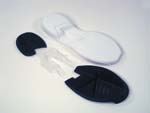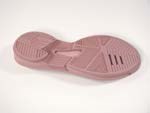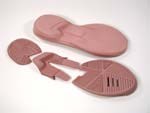Shoe Manufacturer Improves Time To Market With CAM Software
Speed is one of the selling points athletic shoe manufacturers use to market their products: Buy their shoes and you'll run faster. But speed is not just a factor in selling shoes; it has become an essential in their manufacture as well.
Share




Speed is one of the selling points athletic shoe manufacturers use to market their products: Buy their shoes and you'll run faster. But speed is not just a factor in selling shoes; it has become an essential in their manufacture as well.
At the Adidas Footwear Design Center in Portland, Oregon, designers develop prototype shoe soles with various shapes and tread patterns. The prototype begins with a 2D version, which is often a simple sketch. The sketch is given to the design center's CAD department, where a 3D model is developed. The 3D model may be divided into as many as six parts. Each part is individually machined from Ren Shape, a synthetic wood material, on a four-axis mill. The Ren Shape parts are then vacuum cast to create flexible parts. The flexible parts are assembled to form a single model that is put through a series of durability tests.
Once a model passes these tests, it is returned to the designer for approval. If it is approved, then the data from the prototype are sent to a contracted, independent mold shop where a 3D model is cut and a mold is cast from silicone. The finalized sole is then molded and incorporated into the manufacturing process of the shoe.
Adidas' moldmaking and manufacturing operations are performed in Asia. In the past, because the design center did not have a CNC machine, 2D blueprints were sent to Asia and turned into sample 3D models, which had to be approved by the designer in Portland. This process frequently required designers to take expensive flights from Portland to Asia. Because the models often underwent revisions, valuable materials and labor hours were wasted.
To cut costs, Adidas placed a CNC machine at the design center and looked into purchasing CAM software. After researching several companies, Adidas decided to purchase Open Mind Software Technologies' (Southfield, Michigan) hyperMill CAM software. According to Lafe Christopherson, CNC/CAM specialist at Adidas, production time for a detailed prototype model, from design to designer-approved model, has been reduced by about half since the shop began using the software in March 2000. The 3D models are now machined in Portland, reducing the need for trans-Pacific flights and ensuring the formation of accurate molds.
Doing more work in-house also means a shorter time to market and the manufacturing and distribution of more shoes. It also allows Adidas to stay aware of trends in the competitive world of athletic shoes and to react more quickly to those trends.
Adidas takes advantage of several of hyperMill's automated NC programming functions. Z-level roughing and re-roughing are used to remove the largest amount of material in the shortest time. By using an in-process model, the software can keep track of the material left by the previous cutter and only re-machine those areas. Another feature is slope machining, which detects surface angles and applies the appropriate type of machining method based on those angles. This provides the best surface finish possible.
Open Mind has also provided Adidas with a tool that minimizes programming time. Once parameters and other settings are entered into the program, hyperMill's nightShift utility can calculate tool paths for multiple parts without supervision. Mr. Christopherson says this task can take up to three hours, and before nightShift, he would sometimes program tool paths until 3 a.m.
"I can load the part information and go home," Mr. Christopherson says. "The tool paths will be calculated by the beginning of the next day."
Overall ease of use is the quality of hyperMill that Adidas found most attractive. According to Mr. Christopherson, the software makes it easy to set up parts and to create tool paths for machining complicated surfaces. It also integrates with Adidas' CAD program, think3, and it allows users to convert CAD programs directly into NC programs for processing without leaving the CAD desktop.
Reduced training time is another benefit, Mr. Christopherson says. It took just a short time for him to be able to produce an error-free model. And Mr. Christopherson is able to train other employees—some of whom have had no previous CAM experience—to use the software in just one week. "It's just not that hard to pick up," he says.
And, of course, there is speed. The software allows frames to be set and parts to be rotated more quickly, Mr. Christopherson says. He adds that hyperMILL runs extremely fast when working with multi-axis machines.
Adidas has a goal of cutting its prototype-to-market timeline from its current 18 months to 9 months within the next two years. Mr. Christopherson believes that with the help of hyperMill, that goal of increased speed will be easily attained.
Related Content
Can ChatGPT Create Usable G-Code Programs?
Since its debut in late 2022, ChatGPT has been used in many situations, from writing stories to writing code, including G-code. But is it useful to shops? We asked a CAM expert for his thoughts.
Read More6 Machine Shop Essentials to Stay Competitive
If you want to streamline production and be competitive in the industry, you will need far more than a standard three-axis CNC mill or two-axis CNC lathe and a few measuring tools.
Read MoreContinuous Improvement and New Functionality Are the Name of the Game
Mastercam 2025 incorporates big advancements and small — all based on customer feedback and the company’s commitment to keeping its signature product best in class.
Read MoreGenerating a Digital Twin in the CNC
New control technology captures critical data about a machining process and uses it to create a 3D graphical representation of the finished workpiece. This new type of digital twin helps relate machining results to machine performance, leading to better decisions on the shop floor.
Read MoreRead Next
Building Out a Foundation for Student Machinists
Autodesk and Haas have teamed up to produce an introductory course for students that covers the basics of CAD, CAM and CNC while providing them with a portfolio part.
Read More5 Rules of Thumb for Buying CNC Machine Tools
Use these tips to carefully plan your machine tool purchases and to avoid regretting your decision later.
Read MoreSetting Up the Building Blocks for a Digital Factory
Woodward Inc. spent over a year developing an API to connect machines to its digital factory. Caron Engineering’s MiConnect has cut most of this process while also granting the shop greater access to machine information.
Read More






































